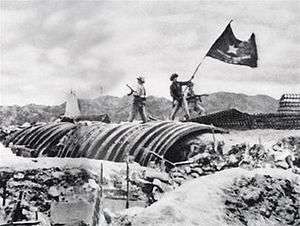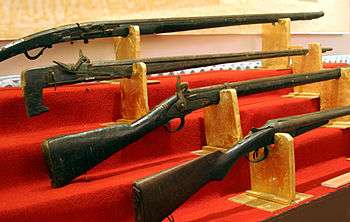Military history of Vietnam
Army and warfare made their first appearance in Vietnamese history during the 3rd millennium BC. Throughout thousands of years, wars played a great role in shaping the identity and culture of people inhabited the land which is modern day Vietnam. Vietnam Trần dynasty got a great victory over Mongols, one of the few such as Japan. Many Vietnamese dynasties got decisive victories over many Chinese dynasties such as the Song, Ming, Qing. Emperor Quang Trung annihilated Chinese armies. Quang Trung's dynasty was succeeded by Nguyen dynasty. Vietnam has gained victory over France, Japan, and USA. Võ Nguyên Giáp is known as one of the greatest generals of the20th century. In Southeast Asia, Vietnamese empires conquered neighbors to the south and west. Overall, Vietnam is famous for defeating invaders who are always bigger. Modern Vietnam is the regional military powerhouse of Southeast Asia.
The military history of the Socialist Republic of Vietnam began when Japan invaded French Indochina and soon defeated the French resistance. Since then, Vietnam has fought in many conflicts in Indochina.
Hong Bang period
Weapons are the most common Bronze Age artifacts found so far. The presence of arms in many tombs of upper-class people indicates the existence of a warrior class in Dong Son society during the Hong Bang period.
Ngo to Ho period
Warfare during this 1500 years period was characterized by combination of amphibious and land assaults. Owing to the fragmented terrain and long coast line of the country, maneuvers by boats were favoured by most military forces who had fought in Vietnam. Small scale coastal and border raiding were frequent. Domestic violence as well as foreign incursions were equally common.It is possible that during this period that Vietnam was at its height of power,first by defeating the southern Han in 937 AD.Then they emerged and decisively defeated the neighboring kingdoms of Khmer Empire,Champa,and the Song (China) dynasty.In the 13th century,the Vietnamese defeated the great Yuan dynasty of the Mongol empire 3 times and Mongols armies were crushed.
Later Le period
Vietnam received firearms from Ming dynasty rule over Vietnam.[1][2] The conquest of Champa was contributed when Vietnam's north received gunpowder weapons from the Ming dynasty along with Neo-Confucianist thought.[3] vietnam already had several victories over Cham before gunpowder.
Around 15th-16th century, firearms started to gain dominance on Vietnam's battlefields. Rivaling feudal lords were quick to adopt these new deadly weapons. Tactics were changed to accommodate guns and cannons and soon the country had as many guns as it could afford.
Nguyen period
- Invasion of French Indochina
The Japanese invasion of French Indochina was a successful Japanese campaign against the French colonial power in Southeast Asia. The invasion was a part of a greater strategy which was meant to surround and isolate China. Following the fall of the French in Indochina, Viet Minh began its campaign against the Japanese occupiers, using guerrilla tactics. The conflict ended when Japan surrendered to the United States, following the bombing of Hiroshima and Nagasaki.
Communist period
- First Indochina War
Following the allied victory in World War II, France was hoping to regain control over its former colony in Indochina, which was also claimed by the Viet Minh. France attempted to invade and reoccupy Vietnam, but after nine years of war, the French gave up and retreated from Indochina. This resulted in Indochina being divided into four countries: North Vietnam, South Vietnam, Laos and Kampuchea.
- Laotian Civil War
The Laotian Civil War began in 1953 when war escalated between the government forces and Pathet Lao, which received support from North Vietnam and China. In addition to their desire to impose a communist government in Laos, Vietnam also wanted to control the strategically important areas in Laos. The conflict ended in 1975, when Pathet Lao seized power in Laos, ending the Kingdom of Laos.
- North Vietnamese invasion of Laos
The North Vietnamese invasion of Laos begun in 1958 as a mixed result of boundary disputes and the Hanoi Regime's desire to control the Ho Chi Minh-path. The invasion was a success, and North Vietnam secured control over important parts of Laos.
- Vietnam War

The Vietnam War started when North Vietnam and the Viet Cong attacked South Vietnam, seeking to reunite the country by force. This led to an American intervention, which lasted until 1973, when they withdrew their forces from Vietnam following a peace treaty. The war went on, and in 1975 North Vietnam emerged victorious.
- Cambodian Civil War
The Cambodian Civil War was a mixed result of the Khmer Rouge's desire to establish a communist regime in Cambodia, eventually dragging Cambodia into the Vietnam War due to the North Vietnamese support for the Khmer Rouge and their use of Cambodian soil to stage attacks into South Vietnam. The US heavily bombed PVA, VC and Khmer Rouge position in Cambodia. Khmer Rouge was aided militarily by the North Vietnam and the Viet Cong, and won the war in 1975.
- Hmong Insurgency
When the Laotian Civil War ended in 1975, the government of Laos started to persecute the Hmong-tribes, who had been fighting alongside the United States in the Vietnam War. Vietnam has participated in the persecution, which has led to thousands of Hmong fleeing to the United States and Thailand. Although the Hmong no longer poses a military threat to the government of Laos, they are still categorized as "bandits" by the authorities.
- Civil unrest in South Vietnam
After the Vietnam War was over, some groups in South Vietnam refused to accept the Hanoi regime as the legitimate government of Vietnam. The resistance lasted until the 1980s, when the rebellion ultimately failed.
- Cambodian-Vietnamese War
When the Vietnam War ended, the Khmer Rouge, which then controlled Cambodia, claimed the Mekong Delta being a historical part of Cambodia. When Vietnam refused to cede the delta to Cambodia, the Khmer Rouge responded by conducting several border skirmishes, infiltrations and sabotage. By the late 1978, Vietnam invaded Cambodia, and after two weeks of fighting, Vietnamese forces captured Pnomh Penh. Vietnam occupied Cambodia until 1988.
- Vietnamese border raids in Thailand
The Vietnamese border raids in Thailand were a Vietnamese attempt to stop the Khmer Rouge from using Thailand as a base when fighting against Vietnam and the Vietnamese-friendly regime in Pnomh Penh. This nearly led to a war, as Vietnamese troops often penetrated into Thai territory, chasing Khmer Rouge guerrillas. This often resulted in clashes between Vietnamese and Thai forces. However, this never led to a war.
- Sino-Vietnamese war
The Sino-Vietnamese War was a Chinese attempt to force Vietnam out of Cambodia. China launched invasion of Vietnam, but faced much tougher resistance than expected. The Chinese invasion lost its progress relatively quickly. The Vietnamese conducted cross-border raids and succeeded in disrupting the Chinese fire support. When the initial offensive had been halted, a new wave of attack was sent in, and eight Chinese divisions were sent into Vietnam. The Chinese penetrated 15–20 km into Vietnamese territory at most, but the price of human life and equipment were very high. Vietnam did not mobilize its regular divisions, which was meant to protect Hanoi if necessary, and no troops were pulled out of Cambodia during the war. In Lang Son, the hardest battles took place. The city was heavily fortified by the Vietnamese Army, and it took 17 counterattacks before the Chinese were able to capture the city. The Vietnamese troops pulled out of the city itself, but established heavy positions in the surrounding mountains. Soon after, Deng Xiaoping announced that China would pull out its forces. 25 Chinese Divisions of the Third Field Army had been taking part of the invasion. Not a single Vietnamese Regular Division had been mobilized, and the Chinese invasion did not affect the Vietnamese presence in Cambodia. In less than a month, according to Western sources, the Chinese Army had suffered some 26,000 KIA and 37,000 WIA. Both sides claimed victory.
- Second Sino-Vietnamese War
When China withdrew all their forces from Vietnam in 1979, they occupied some small areas along the border, and sometimes launched full-scale invasions of Vietnamese cities. The Vietnamese often responded with heavy force. The conflict ended in 1990, when China failed their objective and ended their campaign against Vietnam.
- Thai-Laotian Border War
The Thai-Laotian Border War begun in 1987, when Thailand invaded parts of Laos which they claimed to be theirs. Laos responded with force, and the Thai forces were pushed back to the border. During this brief war, Vietnam reinforced its communist ally, and helped them in their war against Thailand. The war ended with a ceasefire in 1988, when Laos had successfully regained all lost ground, and pushed the Thai forces out of the disputed territory.
Gallery
- Late Đông Sơn metal lamellae (3rd - 1st century BC).
- Armour of Nam Việt (with reconstructed replica) in the 2nd century BC
 Matchlock arquebuses, flintlock musket, percussion cap rifle and double barreled shotgun of medieval and early modern ages.
Matchlock arquebuses, flintlock musket, percussion cap rifle and double barreled shotgun of medieval and early modern ages.- Model of a 17th-century gunboat called "Mông Đồng".
 17th century wood relief showing arquebusier alongside mounted archer. Hương Canh Communal house.
17th century wood relief showing arquebusier alongside mounted archer. Hương Canh Communal house.- 18th and 19th century sabers.
Pictures of Vietnamese weapons from the Pacification of Tonkin were taken by westerners..[4]
Replicas of traditional bladed weapons serve as decorations in Vietnam.[5]
Notes
- ↑ Military Technology Transfers from Ming China and the Emergence of Northern Mainland Southeast Asia (c. 1390-1527) Sun Laichen Journal of Southeast Asian Studies Vol. 34, No. 3 (Oct., 2003), pp. 495-517 Published by: Cambridge University Press on behalf of Department of History, National University of Singapore Stable URL: http://www.jstor.org/stable/20072535 Page Count: 23
- ↑ Michael Arthur Aung-Thwin; Kenneth R. Hall (13 May 2011). New Perspectives on the History and Historiography of Southeast Asia: Continuing Explorations. Routledge. pp. 75–. ISBN 978-1-136-81964-3.
- ↑ Jeff Kyong-McClain; Yongtao Du (2013). Chinese History in Geographical Perspective. Rowman & Littlefield. pp. 67–. ISBN 978-0-7391-7230-8.
- ↑ http://i47.photobucket.com/albums/f178/HappyAsian/sung-than-cong-hue.jpg http://i47.photobucket.com/albums/f178/HappyAsian/vebinh.jpg http://i47.photobucket.com/albums/f178/HappyAsian/guom.jpg http://i47.photobucket.com/albums/f178/HappyAsian/hieu20lenh20va20binh20khi.jpg http://i47.photobucket.com/albums/f178/HappyAsian/binh20khi.jpg http://images9.fotki.com/v178/photos/2/248599/2505348/Narmes_pris_aux_PavillonsNoirs-vi.jpg http://images14.fotki.com/v205/photos/2/248599/2505348/cNinh_le_lendemain_de_sa_chute-vi.jpg http://images14.fotki.com/v206/photos/2/248599/2505348/trailleuses_prises_aux_Chinois-vi.jpg http://images9.fotki.com/v186/photos/2/248599/2505348/ancaise_traversant_RiviereNoir-vi.jpg http://images14.fotki.com/v206/photos/2/248599/2505348/LStropher_armes_annamites-vi.jpg http://images14.fotki.com/v205/photos/2/248599/2505348/STSonTay_dans_la_citadelle-vi.jpg http://images14.fotki.com/v206/photos/2/248599/2505348/STporte_Est_citadelle_SonTay-vi.jpg http://images14.fotki.com/v205/photos/2/248599/2505348/STSonTay_le_soir_dela_prise-vi.jpg http://images14.fotki.com/v206/photos/2/248599/2505348/ns_reservoirs_citadelle_SonTay-vi.jpg http://images14.fotki.com/v205/photos/2/248599/2505348/QDPcanonniere_Eclair-vi.jpg http://images14.fotki.com/v206/photos/2/248599/2505348/orte_dela_citadelle_de_NamDinh-vi.jpg http://hinhxua.free.fr/autrefois/docteur-hocquard/page4/tirailleurs_tonkinois.jpg http://hinhxua.free.fr/autrefois/docteur-hocquard/page3/Absdeurs_chinois_ramenent_prisionn.jpg http://hinhxua.free.fr/autrefois/docteur-hocquard/page6/Tirailleur_saigonnais_tirailleur_annamite.jpg http://hinhxua.free.fr/autrefois/docteur-hocquard/page6/tirailleurs_tonkinois_Linh_Tap.jpg http://hinhxua.free.fr/autrefois/docteur-hocquard/page4/photo_docteur_hocquard_4_vn.htm http://hinhxua.free.fr/autrefois/docteur-hocquard/page3/photo_docteur_hocquard_3_vn.htm http://rusknife.com/uploads/monthly_05_2011/post-458-0-08882000-1305481640.jpg http://hinhxua.free.fr/autrefois/docteur-hocquard/page3/tropher_armes_annamites.jpg http://rusknife.com/topic/2184-%D0%BF%D0%B0%D1%80%D0%BD%D1%8B%D0%B5-%D1%82%D0%B5%D1%81%D0%B0%D0%BA%D0%B8-%D1%85%D1%83%D0%B4%D0%B5%D0%B4%D0%B0%D0%BE/ http://images15.fotki.com/v1631/photos/2/248599/2505348/Narmes_pris_aux_PavillonsNoirs-vi.jpg
- ↑ https://muare.vn/threads/49/do-cung-tien-nha-tho-binh-khi-60cm-bat-buu-bang-dong-binh-khi-1-8m-dodong-vn.2930953/ http://webdoanhnhan.com/raovat/dodongsaigon/cua-hang-ban-bo-binh-khi-phap-khi-tho-bo-bat-buu-cao-2m-bang-dong-tai-sai-gon http://bachhoa24. com/docung-tiennha-tho-binh-khi-60cm-bat-buu-bang-dong-binh-khi-18m-dodong-vn-cl-1316026.html http://defence.pk/attachments/binh-kh%C3%AD-jpg.132762/ http://defence.pk/attachments/binh-kh%C3%AD-2-gif.132763/ http://www.dodong.com.vn/vn/product/138/318/bo-binh-khi-bo-ba-t-bu-u-bo-binh-khi-ba-ng-do-ng-binh-khi-tho-binh-khi-cu-ng-tie-n-va-de-n-chu-a-nha-tho-bo-binh-khi.html http://elearning.smartcom.vn/mod/forum/discuss.php?d=1235 http://rongbay.com/TP-HCM/Bo-do-tho-bat-buu-binh-khi-c291-raovat-17490128.html http://vietnam.net.vn/threads/cua-hang-ban-bo-binh-khi-phap-khi-tho-bo-bat-buu-cao-2m-bang-dong-tai-sai-gon.15094/ http://biz.vngiare.com/view-195528/cua-hang-ban-bo-binh-khi-phap-khi-tho-bo-bat-buu-cao-2m-bang-dong-tai-sai-gon/ http://dodong.vn/sanpham/bat-buu-bang-dongbinh-khi-18m-dodong-vn/ http://www.dodong.com.vn/vn/product/138/318/bo-binh-khi-bo-ba-t-bu-u-bo-binh-khi-ba-ng-do-ng-binh-khi-tho-binh-khi-cu-ng-tie-n-va-de-n-chu-a-nha-tho-bo-binh-khi.html http://elearning.smartcom.vn/mod/forum/discuss.php?d=1235 http://rongbay.com/TP-HCM/Bo-do-tho-bat-buu-binh-khi-c291-raovat-17490128.html http://vietnam.net.vn/threads/cua-hang-ban-bo-binh-khi-phap-khi-tho-bo-bat-buu-cao-2m-bang-dong-tai-sai-gon.15094/ http://biz.vngiare.com/view-195528/cua-hang-ban-bo-binh-khi-phap-khi-tho-bo-bat-buu-cao-2m-bang-dong-tai-sai-gon/ http://aimua24h.com/tin-chi-tiet-xem-sanpham.php/653/5699/cua-hang-ban-bo-binh-khi-phap-khi-tho-bo-bat-buu-cao-2m-bang-dong-tai-sai-gon.html http://raovat.chosaigon.com/show/800658_Bo-binh-khi-dong-bo-bat-buu-bang-dong-tai-ha-noi-Do-dong.html http://bachhoa24. com/bo-bat-buu-8-binh-khi-vat-khi-phong-thuy-vat-pham-phong-thuy-do-phong-thuy-cl-1050664.html http://dangraovat.net/r/143005/cua-hang-ban-bo-binh-khi-phap-khi-tho-bo-bat-buu-cao-2m-bang-dong-tai-sai-gon.html http://raovat.chosaigon.com/show/800659_Cua-hang-ban-bo-bat-buu-binh-khi-bang-dong-de-cung-tien-dinh.html http://aimua24h.com/tin-chi-tiet-xem-sanpham.php/653/5699/cua-hang-ban-bo-binh-khi-phap-khi-tho-bo-bat-buu-cao-2m-bang-dong-tai-sai-gon.html?mobile=no
References
- Cœdès, George. (1966). The Making of South East Asia (illustrated, reprint ed.). University of California Press. ISBN 0520050614. Retrieved 7 August 2013.